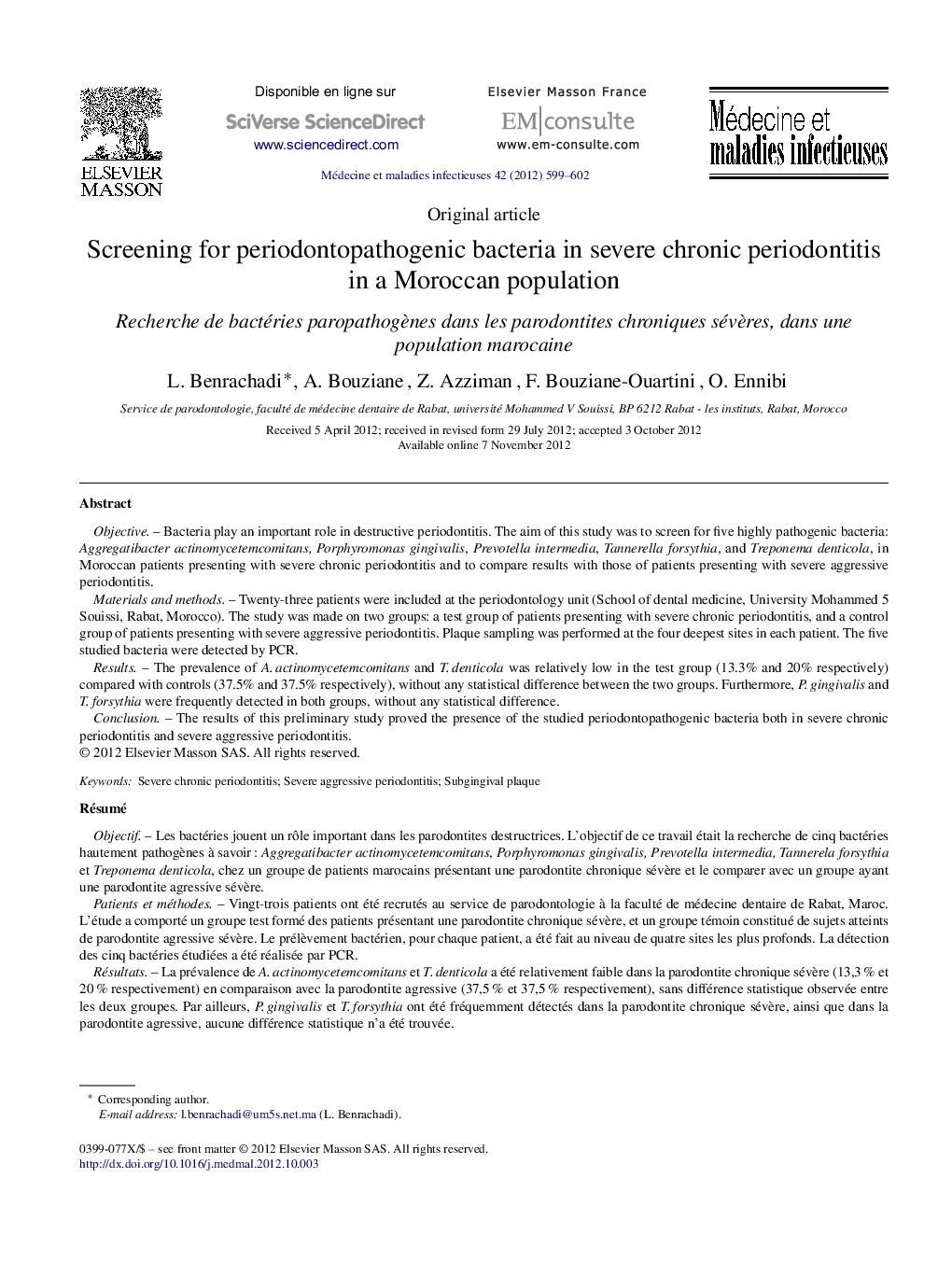| Article ID | Journal | Published Year | Pages | File Type |
|---|---|---|---|---|
| 3413053 | Médecine et Maladies Infectieuses | 2012 | 4 Pages |
ObjectiveBacteria play an important role in destructive periodontitis. The aim of this study was to screen for five highly pathogenic bacteria: Aggregatibacter actinomycetemcomitans, Porphyromonas gingivalis, Prevotella intermedia, Tannerella forsythia, and Treponema denticola, in Moroccan patients presenting with severe chronic periodontitis and to compare results with those of patients presenting with severe aggressive periodontitis.Materials and methodsTwenty-three patients were included at the periodontology unit (School of dental medicine, University Mohammed 5 Souissi, Rabat, Morocco). The study was made on two groups: a test group of patients presenting with severe chronic periodontitis, and a control group of patients presenting with severe aggressive periodontitis. Plaque sampling was performed at the four deepest sites in each patient. The five studied bacteria were detected by PCR.ResultsThe prevalence of A. actinomycetemcomitans and T. denticola was relatively low in the test group (13.3% and 20% respectively) compared with controls (37.5% and 37.5% respectively), without any statistical difference between the two groups. Furthermore, P. gingivalis and T. forsythia were frequently detected in both groups, without any statistical difference.ConclusionThe results of this preliminary study proved the presence of the studied periodontopathogenic bacteria both in severe chronic periodontitis and severe aggressive periodontitis.
RésuméObjectifLes bactéries jouent un rôle important dans les parodontites destructrices. L’objectif de ce travail était la recherche de cinq bactéries hautement pathogènes à savoir : Aggregatibacter actinomycetemcomitans, Porphyromonas gingivalis, Prevotella intermedia, Tannerela forsythia et Treponema denticola, chez un groupe de patients marocains présentant une parodontite chronique sévère et le comparer avec un groupe ayant une parodontite agressive sévère.Patients et méthodesVingt-trois patients ont été recrutés au service de parodontologie à la faculté de médecine dentaire de Rabat, Maroc. L’étude a comporté un groupe test formé des patients présentant une parodontite chronique sévère, et un groupe témoin constitué de sujets atteints de parodontite agressive sévère. Le prélèvement bactérien, pour chaque patient, a été fait au niveau de quatre sites les plus profonds. La détection des cinq bactéries étudiées a été réalisée par PCR.RésultatsLa prévalence de A. actinomycetemcomitans et T. denticola a été relativement faible dans la parodontite chronique sévère (13,3 % et 20 % respectivement) en comparaison avec la parodontite agressive (37,5 % et 37,5 % respectivement), sans différence statistique observée entre les deux groupes. Par ailleurs, P. gingivalis et T. forsythia ont été fréquemment détectés dans la parodontite chronique sévère, ainsi que dans la parodontite agressive, aucune différence statistique n’a été trouvée.ConclusionCette étude préliminaire a montré la présence de ces bactéries paropathogènes aussi bien dans les parodontites chroniques graves que dans les parodontites agressives sévères.
